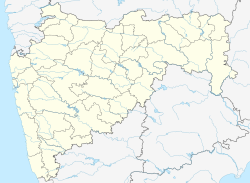Draft:Hivare
Submission declined on 28 June 2025 by Jlwoodwa (talk).
Where to get help
How to improve a draft
You can also browse Wikipedia:Featured articles and Wikipedia:Good articles to find examples of Wikipedia's best writing on topics similar to your proposed article. Improving your odds of a speedy review To improve your odds of a faster review, tag your draft with relevant WikiProject tags using the button below. This will let reviewers know a new draft has been submitted in their area of interest. For instance, if you wrote about a female astronomer, you would want to add the Biography, Astronomy, and Women scientists tags. Editor resources
|  |
Hivare
हिवरे | |
|---|---|
Village | |
| Coordinates: 17°49′08″N 74°11′51″E / 17.8189°N 74.1974°E | |
| Country | |
| State | Maharashtra |
| District | Satara |
| Taluka | Koregaon |
| Time zone | UTC+5:30 (IST) |
| PIN | 415501 |
| Vehicle registration | MH-11 |
Hivare is a village situated in the Koregaon taluka of Satara district in Maharashtra, India. It is located approximately 24 km from Koregaon and about 29 km from Satara, the district headquarters. Covering 878 hectares, the village had a population of 1,378 in around 303 households according to the 2011 Census.[1]
Village Demographics
[edit]According to the 2011 Census,[2] there are 648 males and 730 females, giving a sex ratio of 1,127 per 1,000 (above Maharashtra’s 929 average). The 0–6 age group makes up 11.39% of the population, with a child sex ratio of 847 (compared to the state’s 894). The literacy rate is 77.64% (M=87.03%, F=69.6%), below the state average of 82.34%. The village is administered by an elected Sarpanch and falls within the Koregaon Vidhan Sabha constituency and Satara Lok Sabha constituency.
Economy and Agriculture
[edit]Agriculture dominates Hivare’s economy, with 79.61% of workers in full‑time employment (over six months/year) and 20.39% in marginal work (under six months/year).[2]
Forest Management
[edit]In November 2014, under the Maharashtra Village Forest Rules, Hivare became one of only two villages in Koregaon taluka to receive management rights over approximately 216.9 ha of forest land from the state Forest Department—recognizing its strong record in local forest conservation.[3]
Water Conservation Project
[edit]The village is noted for a successful community-led water conservation project.[4] Built entirely through people’s participation, the project consists of 33 deep continuous contour trenches and small stream channels reinforced by natural and concrete dams, designed to filter runoff into the groundwater. While aiming to percolate around 80 million litres annually, groundwater levels remain a challenge—with borewells reaching depths of 450–600 ft before the project.[4]
Village-level success led to visits and grants from the District Collector, Zilla Parishad CEO, and Koregaon BDO. The Paani Foundation also documented the project during its “Shivar Feri” visits as a model for drought mitigation.
Impact
[edit]- Enabled cultivation of a second annual crop due to improved groundwater.[4]
- Increased sugarcane yields thanks to enhanced moisture.
- Boosted milk production—from 60 L in 1992 to 150 L daily—by improving fodder availability.[4]
- Reduced soil erosion and seasonal migration due to sustainable livelihoods.
Gallery
[edit]-
ZP Secondary School
-
ZP Secondary School
-
ZP Secondary School
-
ZP Secondary School
-
Village Aesthetics
-
Village Aesthetics
-
Temple
References
[edit]- ^ "Census 2011 – Hivare Village, Satara". Retrieved 2025-06-26.
- ^ a b "Census 2011 – Hivare Village, Satara". Retrieved 2025-06-26.
- ^ "Conservation act: Villages get ownership of forests". The Times of India. 8 November 2014.
- ^ a b c d "Hoarding the Rain". Down To Earth. 15 June 1994. Retrieved 2025-06-26.









- Promotional tone, editorializing and other words to watch
- Vague, generic, and speculative statements extrapolated from similar subjects
- Essay-like writing
- Hallucinations (plausible-sounding, but false information) and non-existent references
- Close paraphrasing
Please address these issues. The best way to do it is usually to read reliable sources and summarize them, instead of using a large language model. See our help page on large language models.